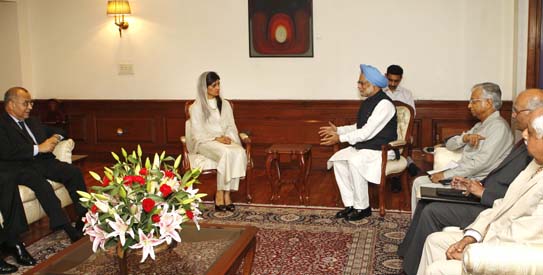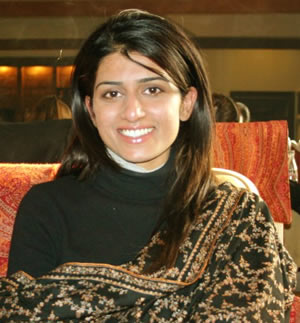The land between KRH and HRK
By Asha’ar Rehman | The Dawn, August 5, 2010
Yesterday

Between Raj Kapoor’s Khush Rang Hina and Hina Rabbani Khar, my Indian friends have essentially been busy in showing off parts of Pakistan that sell to the Indian market - AP Photo
The Indian audiences have been treated to many Pakistani images between Hina Rabbani Khar (already considered worthy of the ‘HRK’ acronym) and Raj Kapoor’s Khush Rang Heena (KRH). I wouldn’t say that they represent two opposite sides of Pakistan. Only to my mind they do signify two opposing Indian approaches to locating the lost Pakistani cousin.

Pakistani perceptions of India are hard to change. Two years after I made my last trip to India, many Pakistanis I meet still wonder if I am speaking the truth when I tell them about the ready friends I found myself surrounded by across the Wagha.
I can see that some of these Pakistanis find it hard to believe how a Pundit who wore a pleasant smile and sported Jeetendra-white patent shoes could take us on a trip through my grandfather’s village. The Pakistanis are perplexed – should I say a wee bit disappointed? – that I never ran into the standard notorious enemy in India. And yes they are amused and patriotically pleased when I relate to them how my little son’s inborn prejudice for the Pakistani flag gave his grownup minders a few anxious moments during that trip.
Since we live in Lahore and away from the flag-infested life in a Kati Pahari or Lyari or an Azizabad, the only flags my younger son, now 5, is familiar with happens to be the national flag of Pakistan. To his uncluttered mind that is the only flag that exists in the world, the result being that over time he has developed this little habit of greeting all flags with the chant of “Pakistan zindabad”.
Pakistan zindabad — This is precisely how he reacted at one instance in India, his inspiration a few flags fluttering atop a Hindu mandir. Back home, there have been occasions where I as a proud father have been made to feel as if, short of installing the Pakistani flag on Laal Qila in Dilli, this is the closest we ever got to (re)conquering India.
The old perceptions of India perpetuate despite our greatly increased and ever increasing exposure to India. And while it will ideally require an Indian to speak on the Indian understanding of Pakistan, there have been bits of evidence thrown up along the path that are, well, a bit puzzling to me.
The old images are difficult to part with. If the emergence of a friendly pundit defies the old reading of an Indian image, the onlooker’s eye is caught by his Jeetendra-white patent shoes. Quite often, I have found the Indian probes of Pakistan as casual and stereotypical as that of a Pakistani who finds a tour of Jamia Masjid in Dilli sufficient to gauge the conditions the Indian Muslims are faced with.
This is a gift of a conditioning of long years which is not easy to get rid of. This is a test of the patience of the slogan chanting peace activists, who have time and again been frustrated by the scuttling of their effort and routinely accused of creating a false illusion of friendship between peoples who do not know each other. The friends of tomorrow must try and know each other better today, they are told by the pro-peace skeptics.
The generation of pre-partition Indians has often been found exploring in today’s Pakistan not a country but essentially old, bygone times – places as they had left behind at the time of their migration.
When Khushwant Singh visited his ancestral village in the Salt Range in 1987, he was overcome as much by a desire to be free to rediscover what was no more there as by the warm welcome that was arranged for him.
When another showman Raj Kapoor indulged in the last cinematic venture of his life, Heena, in the late 1980s, his could be described as a voyage to recapture the essence of an old – innocent – age in the left-behind land of his forefathers.
Between Raj Kapoor’s Khush Rang Heena and Hina Rabbani Khar, my Indian friends have essentially been busy in showing off parts of Pakistan that sell to the Indian market – just as we in Pakistan have been seeking to feed the war and peace sandwich to our consumers. A media salesman myself, I don’t mind that. As a person afraid of the dangers of superficial, hurried relationships, I only wish people were able to earnestly explore the land that exists between KRH then and HRK now.
Along with many others, the rustic Reshmaa (representative of an age or that of a country?) has sold as has done the sufic Nusrat Fateh Ali Khan (as an ambassador of what Pakistan is not and could have been?). The ghazal, as a symbol of a fading culture common to both Pakistanis and Indians, has had many buyers (again reflecting a longing for the beautiful past?). Ajmal Kasab has sold (as what has become of Pakistan after its separation from India?) as has Pakistani flesh flaunted by film performers who would hardly qualify as actors. All due to the unique Indian curiousity about Pakistan.
The Birkin bag, the pearls, the watch have all caught the attention, even though, without your generous help in identifying these objects of desire, I couldn’t have told them from the ones available on the Shah Alami market. The media is right that this doesn’t quite relate to and reflect a country of the poor, a country of the Pakistanis. Precisely my point. The unfortunate fact is that what does make up real Pakistan has not yet been noticed by our neighbours.
Asha’ar Rehman is Dawn’s resident editor in Lahore.